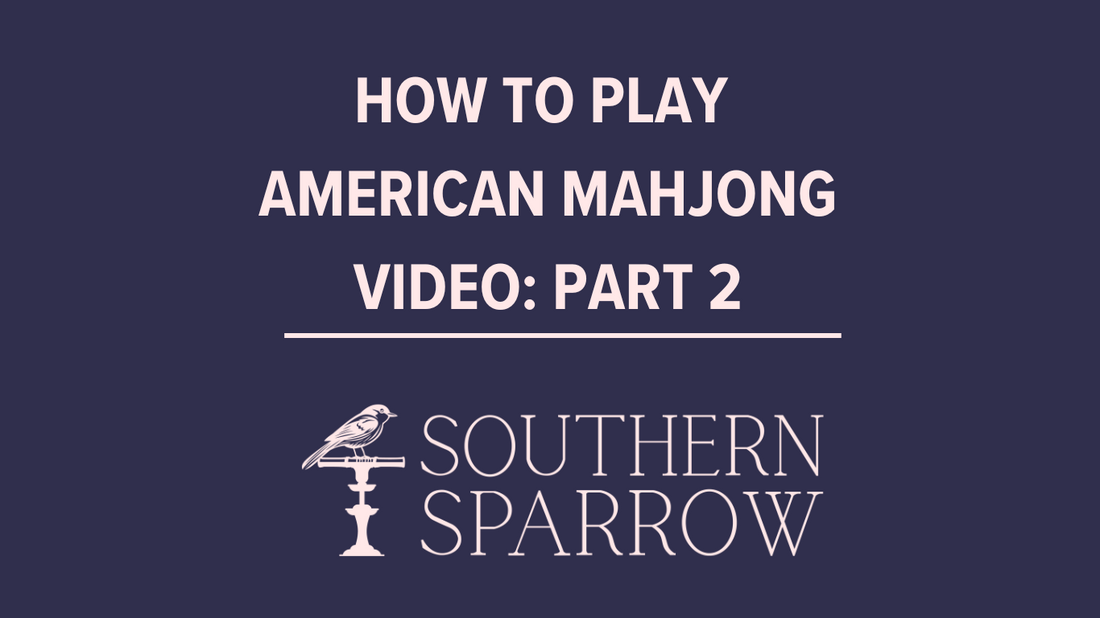This is our second video in our How to Play American Mahjong video series. If you are brand new to the game, start by learning the mahjong tiles in #1 of this series, here: https://www.youtube.com/watch?v=NnRxgQsCtXE
Mahjong is a tile game played all over the world, in many variations. One of the key features of American Mahjong is the NMJL Card. NMJL stands for National Mah Jongg League. The National Mah Jongg League was founded in the mid-1930s as a way to standardize the rules of the game for American players. At that time, many players were coming to the game from multiple variations, which made it difficult for people to play outside of their home group.
Aside from the standards and rules set out by the league, the National Mah Jongg League releases a new card each April. These cards have all of the hands for the year that are played in standard play. While you do not have to play the current year's card, everyone at your mahjong table does need to be playing from the same card.
Today, we are walking through the 2024 NMJL Card. I like this card for new learners because I find it to be an easier card to win on that other cards I have played through my years in the mahjong game. First, let's talk through what the colors mean on the NMJL Card. You'll see three colors: navy, red, and green. The colors on the National Mah Jongg League Card are there to indicate the number of suits in each hand. It is important to note that the colors on the card DO NOT relate back to a specific suit, instead the colors indicate WHERE to CHANGE suits. All navy blue indicates the whole hand will be played in a single suit--this can be either all Bam, all Dot, or all Crack/Crak. Green and red in a line indicates that the hand has two suits, and you will change the suits in your hand to match the pattern on the card. Three colors, red, green, and blue, indicates you will use all three suits in your hand, again changing suits where the colors change on your card to match the pattern shown. Non-suited tiles, Flowers and Winds, do not have a suit and therefore are always shown as navy blue. Flowers are shown as Fs on your card and Winds are shown as the letters of their direction: N=North, E=East, W=West, and S=South.
The NMJL Card is broken out into sections: year, even numbers, any like numbers, addition, quints, consecutive run, odd numbers, winds & dragons, 369, and singles & pairs. I advise new players to avoid playing in the quints or singles & pairs sections until you have 10+ games under your belt.
When you first get tiles from the deal, organize them by suit and number and then try to find what section makes the most sense for your tiles. Remember, you're looking for a section on the NMJL Card not a particular mahjong line or hand. Finding a section right after the deal helps you to know what tiles to keep or pass during the Charleston and will help you narrow in on the mahjong line you are going to go for in the game as the Charleston continues.
When looking at the individual hands (a hand in mahjong is also called a mahjong line), be sure to read the parentheses, as they tell you other ways you can play each line to make the hand more winnable.
For instance, a hand may be shown as FFFF 111 1111 1111 but can be played in any like numbers, meaning you could play it as FFFF 888 8888 8888, as long as you match the pattern of where the suits change. Similarly, a hand may be shown as 11 222 DDDD 333 44 with parentheses that state (Any 4 Consec. Nos. in Any 1 Suit, Kong Opp. Dragons). Those parentheses are telling you that you can play that hand with different numbers than are shown/written as long as they are consecutive and in the same suit. The kong (4 matching tiles) is opposing Dragons, meaning the Dragons are a different suit from the numbers. So, this example hand could be played as 44 555 DDDD 666 77 instead of as it is written. Always be sure to read the parentheses so you can see what other ways you can win a hand. This will all become more intuitive the more games of mahjong you play.
There is a point value assigned to each mahjong line/hand, shown on the right end of each line. You will see that the higher the point value for the hand, the more difficult the hand will be to win your mahj. Next to the point value, you'll see a letter, either X or C. The X stands for exposed, meaning players can call for discarded tiles and expose them on top of their rack ass the game play continues. The C stands for closed or concealed, meaning a player can NOT call for any tiles unless it is the last one needed to win. If you're brand new to playing mahjong, I suggest that you play every hand as exposed for a while just to make it easier to play while you're getting the hang of the rhythm of the game before you layer in that complexity to the game.
You can explore the league and order cards directly from them here: https://www.nationalmahjonggleague.org/index.aspx It does take ~3 weeks to receive if you order from the league. We keep NMJL Cards direct from the league in our inventory, so we can fulfill card orders the next business day. You can find cards direct from the league with a faster delivery time here.
You can find an instructor to teach your group how to play mahjong in person here: https://southernsparrow.com/pages/find-an-instructor

